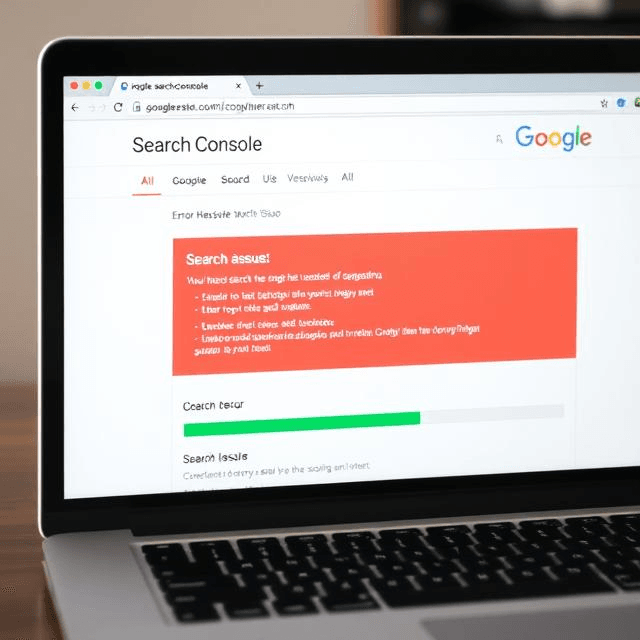Google Search Console (GSC) is an essential tool for website owners, bloggers, and SEO professionals. It helps monitor site performance, fix indexing issues, and ensure better visibility on Google. However, seeing errors like “Crawled – Currently Not Indexed,” “Page with Redirect,” or “Core Web Vitals Errors” can be frustrating. If not fixed, these errors can prevent your site from ranking in search results.

In this guide, we’ll cover all major Google Search Console errors, explain why they occur, and provide quick fixes to resolve them all in just 5 minutes!
Types of Google Search Console Errors and How to Fix Them
1. Indexing Errors
Indexing errors occur when Google struggles to add your page to its index. These errors can prevent your content from appearing in search results.
Common Indexing Errors:
- Crawled – Currently Not Indexed
- Google has crawled your page but decided not to index it.
- Discovered – Currently Not Indexed
- Google knows about your page but hasn’t crawled it yet.
- Excluded by Noindex Tag
- Your page has a
noindextag that prevents Google from indexing it.
- Your page has a
How to Fix:
- For “Crawled – Currently Not Indexed”
- Improve content quality by adding more valuable information, internal links, and images.
- Request indexing in GSC by selecting the page and clicking “Request Indexing.”
- For “Discovered – Currently Not Indexed”
- Ensure your site isn’t overloaded with low-quality pages that slow down crawling.
- Submit an updated sitemap in GSC.
- For “Excluded by Noindex Tag”
- Check your robots.txt and meta tags for
noindex, nofollow. - Remove
noindexfrom pages you want indexed.
- Check your robots.txt and meta tags for
2. Coverage Issues
Coverage issues prevent some pages from appearing in search results.
Common Coverage Errors:
- Submitted URL Blocked by Robots.txt
- Your robots.txt file is stopping Google from crawling your page.
- Page with Redirect
- The URL redirects elsewhere, causing an indexing issue.
- Soft 404 Error
- The page exists but appears empty or irrelevant to Google.
How to Fix:
- For “Submitted URL Blocked by Robots.txt”
- Edit the
robots.txtfile and allow indexing for blocked pages.
- Edit the
- For “Page with Redirect”
- Ensure the redirect leads to a relevant, working page and not a broken link.
- For “Soft 404 Error”
- Improve thin content by adding valuable information and removing incorrect 404 pages.
3. Mobile Usability Errors
Google prioritizes mobile-friendly websites. If your site has mobile usability issues, it may affect your rankings.
How to Fix:
- Test your website using Google’s Mobile-Friendly Test:
https://search.google.com/test/mobile-friendly - Fix common issues:
- Use responsive design to ensure the site adapts to all screen sizes.
- Avoid small fonts and ensure buttons are easy to click.
4. Core Web Vitals Errors
Google’s Core Web Vitals focus on user experience, speed, and interactivity. If your site fails these metrics, your rankings could suffer.
How to Fix:
- Optimize images using TinyPNG (https://tinypng.com).
- Use caching plugins like WP Rocket or Autoptimize.
- Reduce JavaScript and CSS load times to improve page speed.
5. Security and Manual Actions Errors
If Google finds security issues or policy violations, your site might get a manual action penalty.
How to Fix:
- Check your site with Google’s Safe Browsing tool:
https://transparencyreport.google.com/safe-browsing - Use security plugins like Wordfence or Sucuri to scan for malware.
- If you have a manual action, fix the issue and submit a reconsideration request.
6. Sitemap Errors
Your sitemap tells Google which pages to crawl. A broken sitemap can lead to indexing problems.
How to Fix:
- Check your sitemap at:
yourwebsite.com/sitemap.xml - Validate your sitemap using:
https://www.xml-sitemaps.com - Resubmit your sitemap in Google Search Console.
7. HTTPS and Security Issues
If your site has mixed content errors, Google may flag it as insecure.
How to Fix:
- Ensure all links, images, and scripts use HTTPS.
- Update your SSL certificate if it has expired.
- Use Really Simple SSL plugin (for WordPress) to fix HTTPS issues automatically.
8. Server Errors (5xx Errors)
5xx errors occur when your server fails to respond properly to Google’s requests.
How to Fix:
- Check server logs for issues.
- Upgrade your web hosting if your site frequently crashes.
- Use a CDN (Content Delivery Network) to reduce server load.
9. AMP Errors (Accelerated Mobile Pages)
AMP helps mobile pages load faster, but incorrect setup can cause errors.
How to Fix:
- Validate AMP pages using:
https://search.google.com/test/amp - Avoid invalid HTML tags and missing structured data.
10. Structured Data Errors
Structured data helps search engines understand your site’s content better.
How to Fix:
- Test your schema using Google’s Structured Data Testing Tool:
https://search.google.com/test/rich-results - Correct JSON-LD or Microdata errors manually or using a plugin.
Fixing Google Search Console errors doesn’t have to be complicated. By following this guide, you can resolve indexing issues, coverage errors, Core Web Vitals problems, and security warnings—all in just 5 minutes!
Regular Maintenance Tips:
✔ Keep your sitemap updated.
✔ Fix broken links and redirects regularly.
✔ Monitor mobile usability and page speed.
✔ Use security plugins to prevent manual actions.
By keeping your website error-free, you improve your chances of ranking higher on Google, getting more traffic, and ensuring a smooth user experience.


